Sanderlings and Semipalmated Sandpipers, two closely related shorebird species, captivate ornithologists and nature enthusiasts with their intriguing characteristics.
From their distinct plumage to specialized behaviors, these avian wonders embody the diversity of life in coastal ecosystems.
While sharing habitats and general behaviors, they exhibit nuances that set them apart, from breeding plumage transformations to vocalizations that orchestrate their flocks.
Understanding these variations enhances our appreciation of these birds’ adaptations and ecological roles. Delving into the finer details of their differences sheds light on the intricate web of nature’s craftsmanship along the shores they call home.
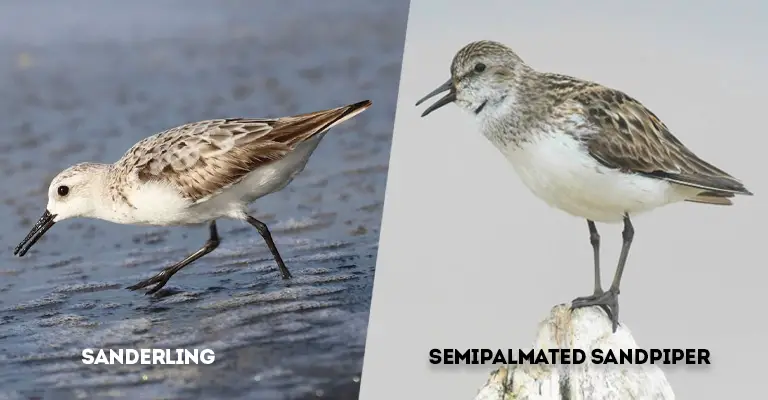
Key Differences Between Sanderlings and Semipalmated Sandpipers
Sanderlings and Semipalmated Sandpipers are both small shorebirds belonging to the family Scolopacidae, but they have several key differences:
Size
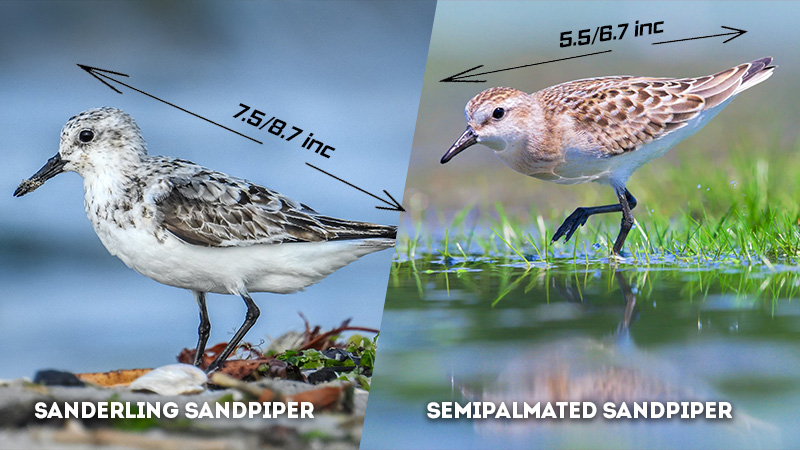
- Sanderlings: Sanderlings exhibit a larger physique, measuring about 7.5 to 8.7 inches (19-22 cm) in length. This size difference sets them apart from Semipalmated Sandpipers. Their relatively larger frame contributes to their distinct appearance and behavior.
- Semipalmated Sandpipers: Contrastingly, Semipalmated Sandpipers are smaller, spanning approximately 5.5 to 6.7 inches (14-17 cm) in length.
This diminutive size is a notable characteristic that distinguishes them from Sanderlings. Their compact stature has implications for their foraging habits and habitat preferences.
Plumage (Nonbreeding)
- Sanderlings: During the nonbreeding season, Sanderlings exhibit a distinctive plumage characterized by a more frosty gray appearance. Their feathers take on a subdued and uniform gray hue, contributing to their overall subtle demeanor.
One of the key identifying features is their clean white breast, devoid of any streaks or markings. - Semipalmated Sandpipers: In the nonbreeding phase, Semipalmated Sandpipers showcase a different plumage pattern.
Their feathers adopt a brownish tone that varies from the gray of the Sanderlings. Their breast features smudgy and lightly streaked patterns, which add a distinct texture to their appearance.
Behavior
- Sanderlings: Sanderlings are renowned for their fascinating behavior of “wave-chasing” along shorelines. As waves retreat, these birds swiftly move in to probe the sand for small invertebrates using their bills.
This behavior is not only visually striking but also plays a crucial role in their feeding strategy. Their agility and synchronicity with the waves enable them to exploit food resources in a unique manner, showcasing their remarkable adaptation to their coastal habitat. - Semipalmated Sandpipers: While Semipalmated Sandpipers also forage along shorelines, their behavior is less prominently associated with wave-chasing compared to Sanderlings.
They engage in probing the sand for food as well, but their style of feeding may not involve the same wave-dependent pattern.
Instead, their feeding approach might emphasize other factors in their habitat, highlighting the diversity of strategies employed by different shorebird species.
Foot Characteristics
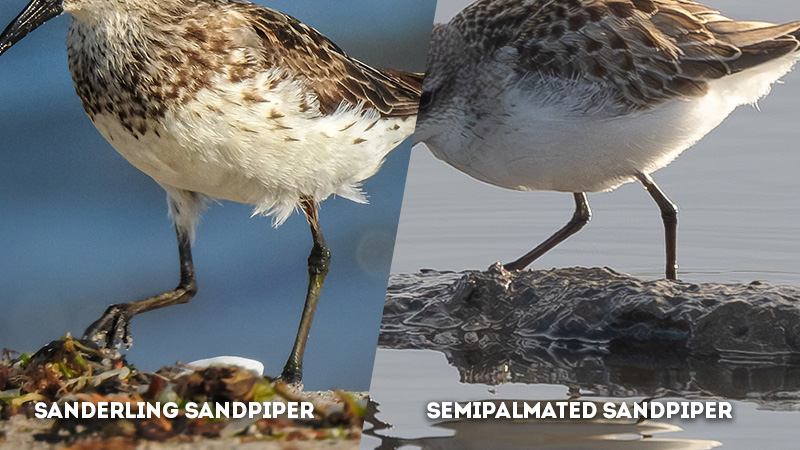
- Sanderlings: Sanderlings exhibit foot characteristics that are notably different from those of Semipalmated Sandpipers. Unlike the latter, Sanderlings do not possess webbed feet.
Their feet are adapted for running and maneuvering on sandy and muddy substrates, which aligns with their wave-chasing behavior.
The absence of webbing facilitates their swift movements along the shoreline as they chase waves and hunt for food. - Semipalmated Sandpipers: Semipalmated Sandpipers derive their name from the partially webbed feet that they possess.
This unique feature sets them apart from Sanderlings and contributes to their ability to navigate various coastal habitats.
The presence of partial webbing offers them enhanced stability and control while traversing different terrains, aiding them in their foraging activities and habitat exploration.
Bill Shape
- Sanderlings: Sanderlings boast a slightly curved bill with a moderate length. This bill shape is well-suited for their feeding strategy of probing and capturing small prey items buried in the sand.
The curvature and length of their bills facilitate efficient probing, enabling them to access hidden food sources with precision. - Semipalmated Sandpipers: Conversely, Semipalmated Sandpipers possess a straight bill that is relatively shorter compared to the bill of Sanderlings. This bill structure reflects their own foraging preferences and strategies.
While they also probe the sand for food, their bill’s design might lead to slightly different feeding behaviors compared to Sanderlings, as their bill shape influences how they interact with their prey and their environment.
Wing Coloration
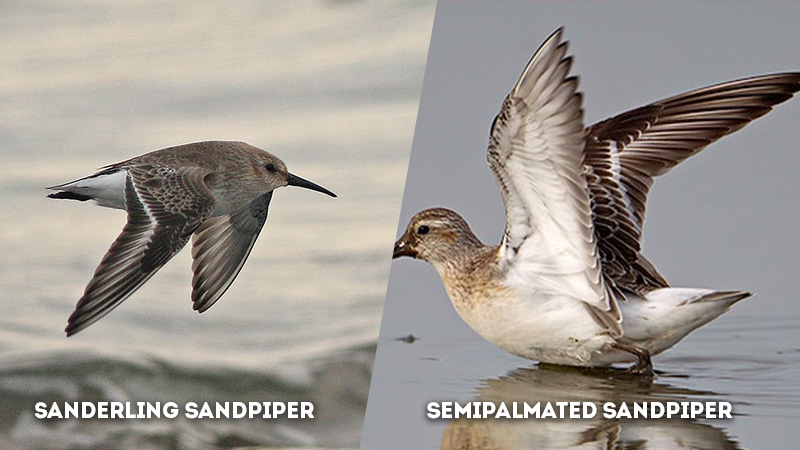
- Sanderlings: Sanderlings possess a characteristic white wing stripe that becomes especially prominent during flight. This distinguishing feature contrasts with the rest of their plumage and aids in their identification, particularly when observing them in motion.
The white wing stripe serves as a key visual cue that sets them apart from other shorebird species, including the Semipalmated Sandpiper. - Semipalmated Sandpipers: Semipalmated Sandpipers exhibit a different wing coloration compared to Sanderlings. Instead of a white wing stripe, they feature a dark wing stripe during flight.
This dark stripe contrasts with their overall plumage and can be useful for distinguishing them from Sanderlings and other similar bird species while they are in flight.
Call
- Sanderlings: Sanderlings are known for their soft, high-pitched calls that are often described as “tik” or “tit.” These calls serve as a means of communication between individuals within their flock and help coordinate their movements and behaviors, especially during activities like foraging along the shoreline.
- Semipalmated Sandpipers: Semipalmated Sandpipers emit distinctive calls that can be characterized as high-pitched and somewhat buzzy.
Their calls are often described as a series of “chip” sounds. These calls play a role in various social interactions among the birds and contribute to the overall soundscape of their habitats.
Habitat Preference
- Sanderlings: Sanderlings are commonly found in sandy beaches, mudflats, and shorelines. These habitats provide them with the ideal substrate for their wave-chasing feeding behavior.
Their preference for open and exposed coastal areas makes them a common sight along sandy shores around the world. - Semipalmated Sandpipers: Semipalmated Sandpipers share similar habitat preferences with Sanderlings. They also frequent sandy beaches, mudflats, and shorelines.
However, their behavior might be slightly different from Sanderlings in these habitats due to their distinctive feeding patterns and strategies.
Breeding Range
- Sanderlings: Sanderlings breed in Arctic tundra and subarctic regions. Their breeding grounds are characterized by vast open landscapes, where they establish nests and raise their young during the short summer breeding season.
- Semipalmated Sandpipers: Semipalmated Sandpipers also breed in Arctic and subarctic regions, particularly in North America. Like Sanderlings, they undertake long migrations to reach their breeding grounds, where they engage in nesting and raising their young.
Migration Pattern
- Sanderlings: Sanderlings are known for their impressive long-distance migrations. They travel great distances between their breeding grounds in the Arctic and their nonbreeding areas in various coastal regions, spanning the Americas, Europe, Africa, and beyond.
- Semipalmated Sandpipers: Semipalmated Sandpipers also exhibit long-distance migration patterns, covering significant distances between their breeding areas in the Arctic and their wintering habitats across the Americas. Their migratory behavior underscores their adaptability and ability to navigate varied landscapes.
Breeding Plumage
- Sanderlings: During the breeding season, Sanderlings undergo a transformation in their plumage. Their feathers become darker, displaying rusty and black markings on their belly.
This change in coloration serves as a signal for their breeding readiness and also provides camouflage in their Arctic breeding habitat. - Semipalmated Sandpipers: Semipalmated Sandpipers also experience a change in their plumage during the breeding season.
Their feathers take on a reddish-brown hue with more distinct markings, contributing to their breeding readiness and enhancing their appearance for courtship and mating.
Eye Stripe
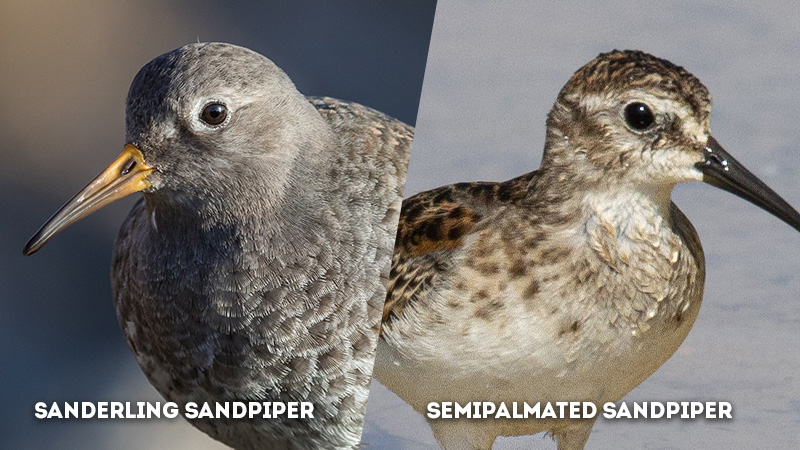
- Sanderlings: Sanderlings exhibit a prominent white eye stripe that contrasts with the rest of their plumage. This distinctive eye stripe adds a touch of elegance to their appearance and contributes to their overall visual appeal.
- Semipalmated Sandpipers: Semipalmated Sandpipers possess a less prominent eye stripe compared to Sanderlings. While their eye stripe is still visible, it might be less striking than the prominent white eye stripe of Sanderlings.
Leg Color
- Sanderlings: Sanderlings have black legs, which contrasts with their lighter plumage and adds a striking visual element to their appearance. The black legs are particularly noticeable when they are foraging along the shoreline or standing in sandy habitats.
- Semipalmated Sandpipers: Semipalmated Sandpipers possess legs that are darker in color, often with a greenish tinge. This leg coloration contributes to their camouflage in various coastal habitats and helps them blend in with their surroundings.
Tail Plumage
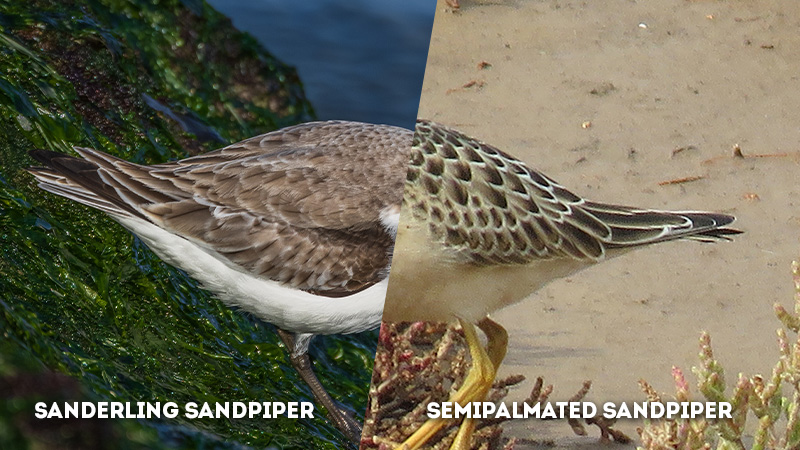
- Sanderlings: Sanderlings display a distinct tail plumage during the nonbreeding season, featuring a white tail with a narrow dark band at the tip. This tail pattern can be observed both during flight and while they are on the ground.
- Semipalmated Sandpipers: Semipalmated Sandpipers showcase a different tail plumage pattern. Their tail is primarily dark in color, with white edges.
This tail pattern contrasts with their body plumage and can be a useful identifying feature, especially when observing them from behind.
Head Shape
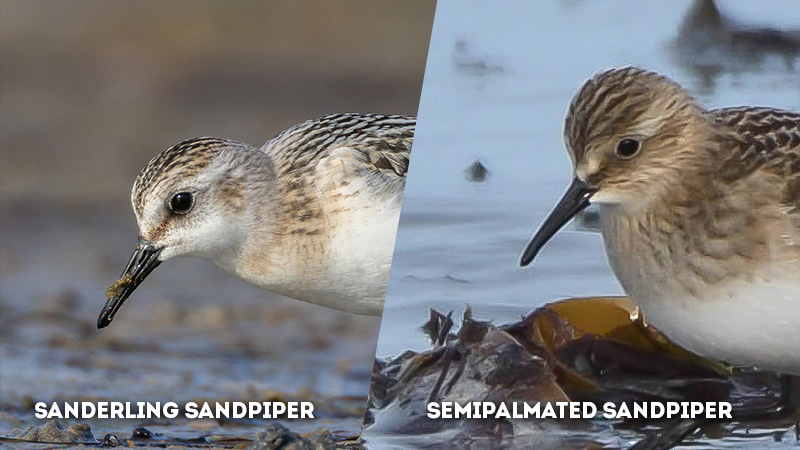
- Sanderlings: Sanderlings are characterized by a rounded head shape, which contributes to their overall compact appearance. This head shape aligns with their general body proportions and complements their agile movements along shorelines.
- Semipalmated Sandpipers: Semipalmated Sandpipers possess a more slender and tapered head shape compared to the rounded head of Sanderlings. This difference in head shape adds to their distinctive profile and can be observed when viewing them from various angles.
Neck Length
- Sanderlings: Sanderlings are characterized by a relatively short neck. This feature contributes to their compact and streamlined body shape, which is well-suited for their wave-chasing behavior along shorelines.
- Semipalmated Sandpipers: Semipalmated Sandpipers possess a longer neck compared to Sanderlings. This longer neck can influence their foraging strategies and overall posture while navigating their coastal habitats.
Coastal Behavior
- Sanderlings: Sanderlings are often associated with the captivating behavior of “wave-chasing.” They adeptly follow the ebb and flow of waves along shorelines, utilizing the exposed sand to search for food. This behavior is a distinctive characteristic that sets them apart.
- Semipalmated Sandpipers: While Semipalmated Sandpipers also frequent coastal areas, their behavior might differ from the wave-chasing approach of Sanderlings. Their coastal behavior is likely influenced by their unique foraging strategies and interactions with their environment.
Flock Size
- Sanderlings: Sanderlings are known to gather in larger flocks, especially during migration and in their nonbreeding habitats. These flocks can consist of numerous individuals, creating a dynamic and bustling presence along coastlines.
- Semipalmated Sandpipers: Semipalmated Sandpipers may form smaller flocks compared to Sanderlings. Their flock sizes might vary depending on factors such as habitat availability and social dynamics within their populations.
Bill Length
- Sanderlings: Sanderlings possess a moderately long and slightly curved bill. This billing structure suits their feeding strategy of probing into the sand to uncover small invertebrates, allowing them to efficiently capture their prey.
- Semipalmated Sandpipers: Semipalmated Sandpipers have a relatively short and straight bill compared to Sanderlings. This bill design influences their foraging behavior and how they interact with their prey and habitat.
Overall Coloration
- Sanderlings: Sanderlings exhibit a subdued and uniform coloration during the non-breeding season. Their frosty gray appearance with a clean white breast creates a cohesive and elegant look that contributes to their distinctive presence.
- Semipalmated Sandpipers: Semipalmated Sandpipers showcase a distinct overall coloration during the non-breeding season.
Their brownish plumage, coupled with a smudgy and lightly streaked breast, adds a layer of complexity to their appearance that sets them apart from Sanderlings and other shorebird species.
Sanderling vs. Semipalmated Sandpiper: Comparison Table
| Aspect | Sanderlings | Semipalmated Sandpipers |
|---|---|---|
| Size | Larger, around 7.5 – 8.7 inches (19-22 cm) | Smaller, about 5.5 – 6.7 inches (14-17 cm) |
| Plumage (Nonbreeding) | Frosty gray with clean white breast | Brownish with smudgy, lightly streaked breast |
| Behavior | Often seen wave-chasing along shorelines | Feed along shorelines, less focused on wave-chasing |
| Foot Characteristics | Notably not webbed feet | Partially webbed feet |
| Bill Shape | White tail with a narrow dark band at tip | Straight, relatively short |
| Wing Coloration | White wing stripe in flight | Dark wing stripe in flight |
| Call | Soft, high-pitched “tik” or “tit” call | High-pitched, buzzy “chip” call |
| Habitat Preference | Sandy beaches, mudflats, and shorelines | Similar habitats to Sanderlings |
| Breeding Range | Arctic tundra and subarctic regions | Arctic and subarctic regions |
| Migration Pattern | Long-distance migrator | Long-distance migrator |
| Breeding Plumage | Darker with rusty and black markings on belly | Reddish-brown, with more distinct markings |
| Eye Stripe | Prominent white eye stripe | Less prominent eye stripe |
| Leg Color | Black legs | Darker with rusty and black markings on the belly |
| Tail Plumage | Dark legs, often with a greenish tinge | Dark tail with white edges |
| Head Shape | Rounded head shape | More slender, tapered head |
| Neck Length | Short neck | Longer neck |
| Coastal Behavior | Frequently seen on coasts and beaches | Coastal and estuarine habitats |
| Flock Size | Often found in larger flocks | May form smaller flocks |
| Bill Length | Moderately long bill | Relatively short bill |
| Overall Coloration | Subdued and uniform | Browns and whites with contrasting patterns |
Frequently Asked Questions
Sanderlings and Semipalmated Sandpipers both breed in Arctic and subarctic regions, but they might exhibit different nesting preferences. Sanderlings are known to nest in open tundra areas, often on higher ground, while Semipalmated Sandpipers might favor slightly wetter and more vegetated locations near water sources.
The white wing stripe of Sanderlings aids in their identification during flight, helping observers distinguish them from other shorebirds. Semipalmated Sandpipers’ dark wing stripe serves a similar purpose. These markings are crucial for flock cohesion and navigation during migration.
During the nonbreeding season, Sanderlings often frequent open sandy beaches and mudflats for their wave-chasing feeding behavior. Semipalmated Sandpipers also use similar habitats but might show a preference for estuaries and coastal wetlands, where they can find suitable food sources.
The contrasting plumage of Sanderlings and Semipalmated Sandpipers is likely related to their camouflage strategies. Sanderlings’ subdued gray appearance helps them blend in with sandy environments, while Semipalmated Sandpipers’ brown and streaked plumage might provide camouflage in a broader range of coastal habitats.
Both species use vocalizations to communicate within their flocks, helping to coordinate movements and behaviors. Sanderlings’ soft “tik” or “tit” calls and Semipalmated Sandpipers’ buzzy “chip” calls aid in flock cohesion, ensuring effective foraging and navigation during migration.
To Recap
In the intricate tapestry of avian biodiversity, Sanderlings and Semipalmated Sandpipers stand as remarkable threads, woven by nature’s artistic hand.
Their unique attributes, showcased through distinctive plumage, behavior, and adaptations, underscore the awe-inspiring complexity of coastal ecosystems.
As we delve into the intricate details that set them apart, we gain not only a deeper appreciation for these shorebirds but also a broader understanding of the delicate balance that sustains our natural world.
Through their differences, Sanderlings and Semipalmated Sandpipers offer a window into the enchanting symphony of life along the shorelines they inhabit.
